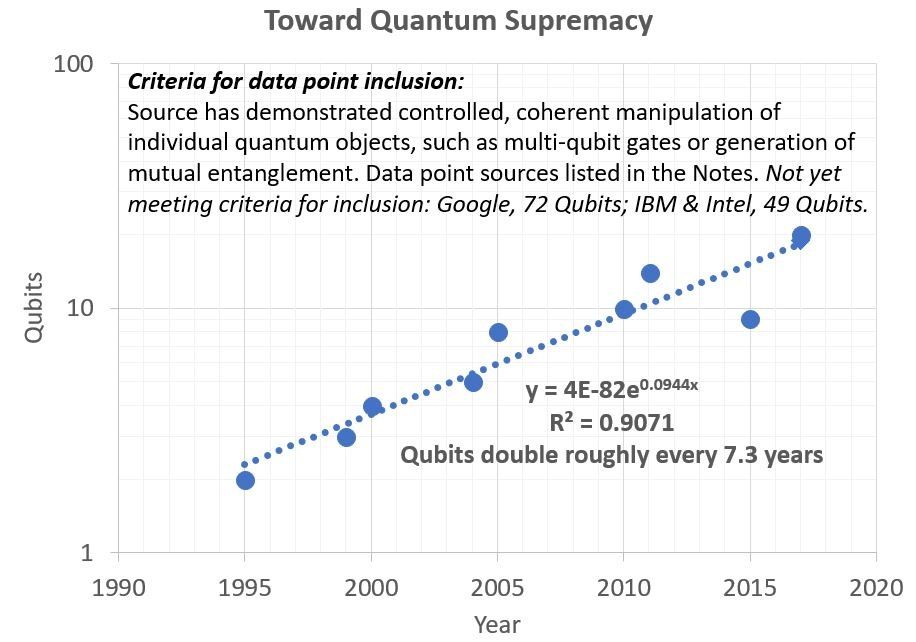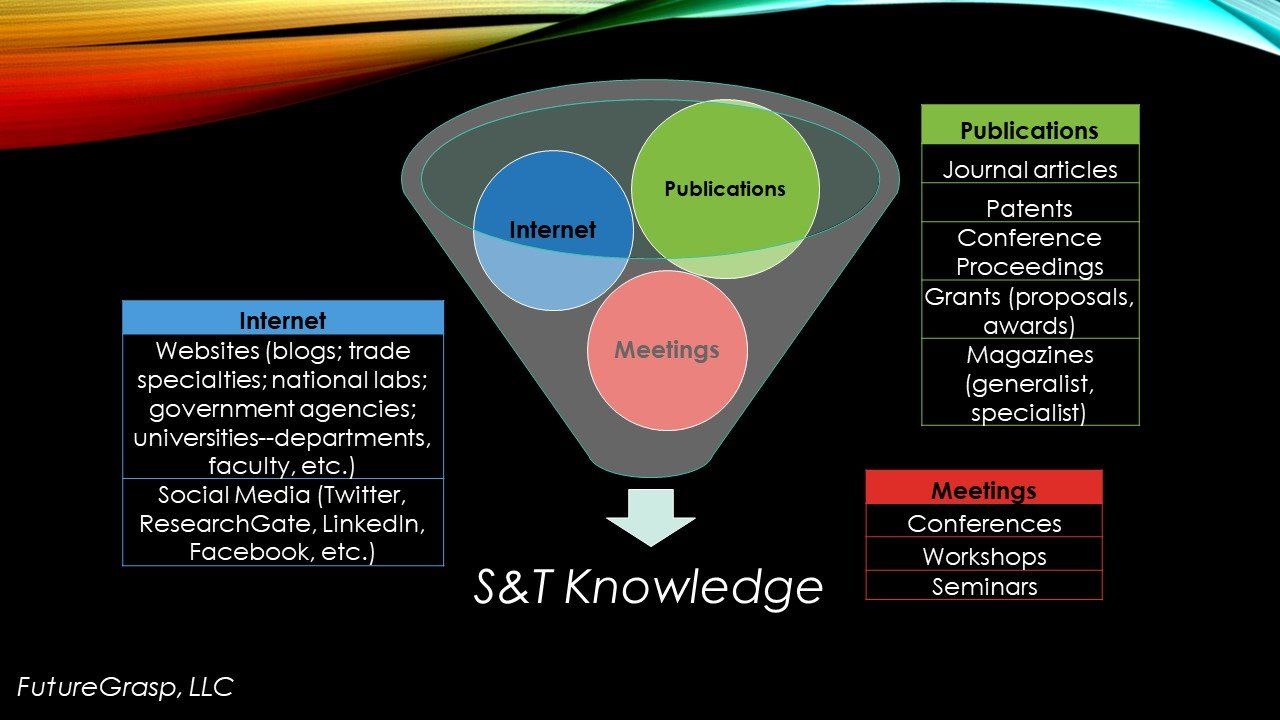Quantum Supremacy is Near
Toward Quantum Supremacy [1]
Can you imagine being able to solve complex problems almost instantaneously? What would normally take months would take minutes. Seemingly impossible questions would become straightforward to answer. In the world of quantum computing, we are close to doing just that. Quantum supremacy, the point at which a quantum computer exceeds the capabilities of any classical computer [2] , is now near at hand. “A successful demonstration of quantum supremacy would prove that engineered quantum systems, although still in their infancy, can outperform the most advanced classical computers.” [3]
For over 50 years, Moore’s Law—with the international support of the industrial consortium SEMATECH—drove the central processing unit (CPU) to achieve a doubling of the number transistors roughly every two years. The trillion-dollar semiconductor industry was reliant upon this exponential; it arguably enabled the entire information technology (IT) industry that we have today. Recently, though, Moore’s Law has faltered and the classic transistor number doubling within two years no longer occurs. Clock speeds have also slowed since the integrated circuits (ICs) simply fry and fail if they are run too fast. Moreover, the cost of a new fabrication (fab) plant for ICs now exceeds $10 billion, meaning only the largest companies can afford them. Essentially, the semiconductor industry can no longer maintain Moore’s Law with traditional silicon-based ICs.
But the death of Moore’s Law does not mean that advanced computing ceases its acceleration. [4] On the contrary, technologies such as QC are picking up where CPUs falter. Blazing fast computational speed is the leverage that the nonlinear QC architecture offers beyond the linear computing CPU. QC has the potential to spot patterns extremely quickly within large data sets. “It might be possible for the quantum computers to access all items in your database at the same time to identify similarities in seconds.” [5]
Traditional semiconductor chips operate with bits that are either ‘on’ or ‘off’ depending on their electrical state; quantum computers work differently and have unique technical challenges. Quantum computing (QC) uses qubits , in which an individual bit can be in one of three states: on, off, and, uniquely, both on and off simultaneously. Moreover, QC demands cooling of the processing chip to fractions of a single digit Kelvin to avoid disturbing processing in the qubits. QC also requires wholly new approaches to software since the binary on/off paradigm is no more, and instructions do not load sequentially, but rather execute simultaneously .
But how rapidly is QC advancing? Harkening back to Moore’s Law, I was curious if QC might be following a similar development path. Taking all the available literature data [6] , I graphed the number of qubits available from multiple research efforts over time. The criteria for a data point’s inclusion are that the qubit result has demonstrated controlled, coherent manipulation of individual quantum objects, such as multi-qubit gates or generation of mutual qubit entanglement. This strict criteria obviates inclusion at this writing of a number of recent, higher number qubit announcements, such as IBM’s and Intel’s independent 49 qubit chipsets [7] , [8] and Google’s 72 qubit chipset [9].
Amazingly, the result is another exponential. With a residual-squared graph fit of ~0.91 (decent for a random data plot), it is shown that the number of qubits doubles roughly every 7.3 years.
How many qubits are needed to achieve quantum supremacy is up for debate, but certainly a higher number is recognized as necessary. The threshold number will be driven by factors such as the demonstrated application of multi-qubit gates or the generation of mutual qubit entanglement, as well low error rates for a given qubit chipset. A low error rate might allow quantum supremacy to be achieved at around 50 qubits. “For quantum supremacy, Google will need to build a 49-qubit system with a two-qubit fidelity [a measure of how error-prone the process is] of at least 99.7 percent [where a higher number denotes lower error].” [10] Thus, assuming the graph fit stays the same in coming years, quantum supremacy might be achieved by roughly 2026, eight years from now. However, Google believes that quantum supremacy might be achieved within even 2018 [9], assuming their 72 qubit chipset possesses low error rates, and meets our graph’s criteria.
Whatever the final qubit number necessary, we are arguably looking at achieving quantum supremacy within the next few years at most.
The implications of quantum supremacy will be profound. “…what is really exciting about quantum computing is that we have good reason to believe that a quantum computer would be able to efficiently simulate any process that occurs in Nature.” [11] Potential applications of QC range over the whole economic spectrum. As detailed on the website of Rigetti Computing [12] , a Silicon Valley startup that recently met the graph’s criteria for 19 qubits, QC can be applied in difficult problems in areas such as physics, chemistry, materials science, medicine, transportation and logistics, and neuroscience and artificial intelligence (AI). The challenge for applying quantum supremacy will be not so much finding problems that need tackling, but rather crafting the problems in ways that a quantum computer can handle them.
Challenges Remaining
Of course, technical and business challenges remain before any research group or company can claim the trophy of quantum supremacy; I note three categories:
Hardware. The pursuit of more qubits for a given multi-qubit chipset or collection of entangled qubits is of paramount importance. We should expect to see more announcements in the coming months and years of increasing qubit numbers. Assuming we maintain an exponential graph fit as shown in the figure, organizations developing quantum computers will certainly be exciting to watch.
Programming. Programming of QC remains a challenge…how do you code for a computer that uploads and executes all its instructions simultaneously? QC programming, as we noted in the BootstrapLabs Applied AI Conference panel on the “Death of Moore’s Law,” [4]presents a tremendous growth opportunity for startups. Companies such as Rigetti Computing already offer access through an API (application program interface) for QC in the cloud. [13] Programmers interested in exploring the opportunities presented by QC are encouraged to engage with such QC leaders.
Scale-up. Like any new technology, scale-up will be an issue for QC. Just because something works well in the lab, doesn’t mean it will work at scale when thousands of programmers wish to access a quantum computer that has demonstrated quantum supremacy. More investment and greater recognition within the computer science community of the power of QC will help ensure wider QC availability.
…not Conclusions
It is challenging to make hard conclusions on QC today, because this incredibly promising field is really just starting. Companies both big (for example, Google, IBM, Intel) and smaller (for example, Rigetti Computing) are investing hundreds of millions of dollars in the chase for quantum supremacy and the consequent ability to leverage the power of the quantum world. Industry recognizes that QC is now approaching a technical inflection point. The barrier at which problems that cannot be solved by any classical computer might soon be overcome with the quantum computer.
Acknowledgements
I gratefully acknowledge Mr. Madhav Thattai of Rigetti Computing for insights and select data points on the figure, as well as his comments on our panel at the BootstrapLabs Applied AI Conference in San Francisco, CA on April 12, 2018.
Notes
[1] Note that an alternative term preferred by some researchers is “quantum advantage.” The distinction between supremacy and advantage is straightforward: supremacy is a benchmark, advantage is an application. [personal communication, Madhav Thattai, Rigetti Computing]
[2] J. Preskill, 13 NOV 2012, “Quantum computing and the entanglement frontier,” WSPC – Proceedings, arXiv:1203.5813v3, https://arxiv.org/pdf/1203.5813.pdf
[3] Neill, et al., 13 APR 2018, “A blueprint for demonstrating quantum supremacy with superconducting qubits,” Science, 360 (6385), 195-198.
[4] T. Campbell, 12 APR 2018, “Death of Moore’s Law—and the Birth of New Semiconductor Industries and AI,” BootstrapLabs Applied AI Conference, San Francisco, CA, keynote and panel.
[5] B. Marr, 5 SEP 2017, “How Quantum Computers Will Revolutionize Artificial Intelligence, Machine Learning And Big Data,” Forbes, https://www.forbes.com/sites/bernardmarr/2017/09/05/how-quantum-computers-will-revolutionize-artificial-intelligence-machine-learning-and-big-data/#2d0bf8df5609
[6] Graph modified from “Moore’s Law for Quantum Computers,” 2011, http://www.quantenblog.net/physics/moores-law-quantum-computer ; links for all data point sources are listed below:
| Source |
Year |
Qubits |
| https://journals.aps.org/prl/abstract/10.1103/PhysRevLett.75.4714 |
1995 |
2 |
| https://journals.aps.org/prl/abstract/10.1103/PhysRevLett.82.1345 |
1999 |
3 |
| 2000 |
4 |
|
| 2004 |
5 |
|
| 2005 |
8 |
|
| 2010 |
10 |
|
| https://journals.aps.org/prl/abstract/10.1103/PhysRevLett.106.130506 |
2011 |
14 |
| https://www.technologyreview.com/s/544421/googles-quantum-dream-machine/ |
2015 |
9 |
| https://medium.com/rigetti/unsupervised-machine-learning-on-rigetti-19q-with-forest-1-2-39021339699 |
2017 |
19 |
| 2017 |
20 |
[7]
E. Pednault, 27 OCT 2017, “Quantum
Computing: Breaking Through the 49 Qubit Simulation Barrier,” IBM Blog,
https://www.ibm.com/blogs/research/2017/10/quantum-computing-barrier/
[8] J. Hsu, 9 JAN 2018, “CES 2018: Intel's 49-Qubit Chip Shoots for Quantum Supremacy,” IEEE Spectrum, https://spectrum.ieee.org/tech-talk/computing/hardware/intels-49qubit-chip-aims-for-quantum-supremacy
[9] J. Kelly, 5 MAR 2018, “A Preview of Bristlecone, Google’s New Quantum Processor,” https://research.googleblog.com/2018/03/a-preview-of-bristlecone-googles-new.html.
[10] M. Reynolds, 22 JUN 2017, “Google on track for quantum computer breakthrough by end of 2017,” https://www.newscientist.com/article/2138373-google-on-track-for-quantum-computer-breakthrough-by-end-of-2017/
[11] J. Preskill, 27 JAN 2018, “Quantum computing in the NISQ era and beyond,” arXIV:1801.00862v2











